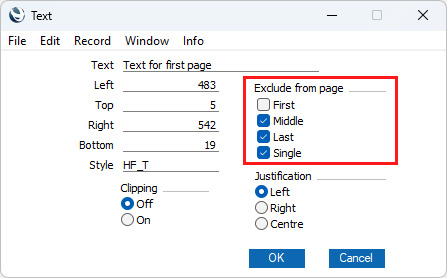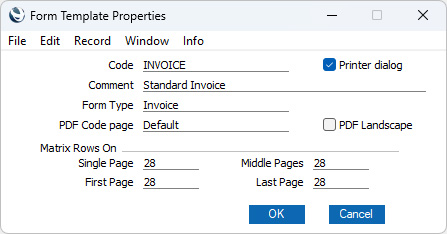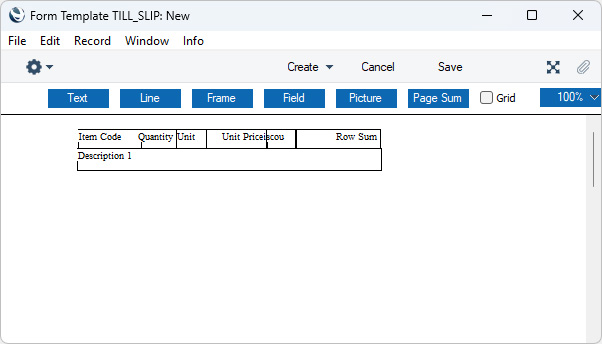Single- and Multi-Page Forms
This page describes designing Form Templates to cater for the printing of multi-page documents.
---
When you design a Form Template, you should consider what is to happen when the printing of a document requires more than one page. Two options are available:
- The "simple" option, where the same page design is used for each page.
- The "multi-page" option allows the use of up to four page designs, as follows:
- First
- The first page of a multi-page document.
- Middle
- The pages between the first and last pages in a multi-page document.
- Last
- The last page of a multi-page document.
- Single
- The sole page of a single-page document.
When you add an object of any kind (i.e.
text,
line, frame, field,
picture or
page sum) to a Form Template design, you can use the Exclude From Page check boxes to specify the pages on which the object is to be printed. If you do not tick any of these boxes, the object will be printed on every page. This will be the case when using the "simple" option. If you want the object to be printed on certain pages only, tick one or more of the boxes. For example, if the object is to be printed on all pages except the first, tick the First box. If it is only to be printed on the first page, tick every box except the First box (i.e. it will be excluded from all pages except the first). The text object in the illustration below will be printed on the first page only:

To help with the design process, you can choose to display the objects from a particular page only. To do this, select 'First Only', 'Middle Only', 'Last Only' or 'Single Page Only' as appropriate from the Operations menu. For example, select 'First Only' to view the objects that are to be printed on the first page (i.e. those whose First box has not been ticked). Select 'View All' to see all objects, irrespective of the page on which they are to be printed.
The number of pages printed will vary from record to record, depending on the number of rows that the record has. An Invoice with one Item will be printed on a single page (i.e. using those objects whose Single box is not ticked). An Invoice with 100 Items (i.e. 100 rows) will be printed over several pages. You should specify the maximum number of rows that can be printed on each page by selecting 'Properties' from the Operations menu. This opens the 'Form Template Properties' window, which has four fields under the overall heading of Matrix Rows On:

In the case of the "simple" option, you should enter the same number to each of these four fields. Otherwise, enter different numbers as appropriate. For example, in an Invoice Form Template, First and Single are set to 5, Middle to 6 and Last to 7. Invoices will be printed as follows, depending on the number of rows:
| Invoice rows | Pages | Type of Page |
| Up to 5 | 1 | Single |
| 5-12 | 2 | First and Last |
| 13-19 | 3 | First, Middle and Last |
| 19-25 | 4 | First, 2 x Middle, Last |
If you do not want any matrix rows to be printed on a particular page type, enter "-1" in the relevant field. Entering "0" will signify that you want every matrix row to be printed.
If you specify that you want matrix rows to be printed on a particular page type, ensure that you have added some matrix fields to that page type. For example, if you have specified that ten matrix rows will be printed on the first page, ensure you have added some matrix fields that you have not excluded from the first page to print those rows. If you do not add any fields to the first page, the print engine will still try to print the ten rows on the first page and will start the next page with row 11. The effect will be that the first ten rows will not be printed.
Printing Cash Receipts (Till Slips)
If you need to print Cash Receipts from POS Invoices, the design of the Form Template will depend to some extent on the printer that you are using. Some suggestions are:
- Place the header information including any column headings on the first page only.
- One option is to specify that no matrix rows will be printed on the first page (i.e. in the 'Properties' window, enter "-1" in the Single Page and First Page fields) and one row will be printed on the last page (enter "1" in the Last Page field). This will mean that every till receipt will be printed using the first page, an appropriate number of middle pages, and the last page.
- You can also specify that only one matrix row will be printed on each middle page (i.e. in the 'Properties' window, enter "1" in the Middle Page field).
- When adding matrix fields to the middle page, remember to set the Format to "Matrix" and to specify a Line Height.
- You can place the "Description 1" field above or below the fields that will print the Item Number, quantity and price information. This will give more space for long Item Names.

If you do this and you specified that more than one matrix row will be printed on each middle page, you will need to double the Line Height in each field.
- Place the totals and footer information on the last page, at the top of the page.
- In the 'Properties' window, do not tick the Printer dialog option. In a Point of Sales environment, it will probably not be necessary for cashiers to process a printer dialogue for every till receipt.
- Depending on the printer, you may also need to select 'PC Printer' from the Operations menu, enter "1" in the Rows Per Page field and tick the End Page with Form Feed (FF) option, as well as specifying a Codepage.
- In a mixed network with Windows and macOS tills, you may need a separate Form Template for each operating system. If so, you can ensure the appropriate Form Template will be printed from each till using Languages. Assign a Language (for example, Mac or Windows) to each cashier (in their Person records) and then enter a row for each Language/operating system in the 'Form Definition' window:

Please refer to the Printing Forms page for more details about the 'Form Definition' window.
Page Sums
If you need running totals to be printed on each page, add page sums to the Form Template. For example, when printing a multi-page Invoice, you can use page sums in the following ways:
- You can add a page sum to the top of the Middle and Last pages that will print the total value of the preceding pages.
- You can add a page sum to the bottom of the First and Middle pages that will print the total value of the page in question, or total value of the page in question and all preceding pages.
Please refer
here for details about page sums.
Page Numbers
If you need a page number to be printed on each page, add the "Page Number" field to the Form Template design.
---
The Form Template register in Standard ERP:
Go back to:
